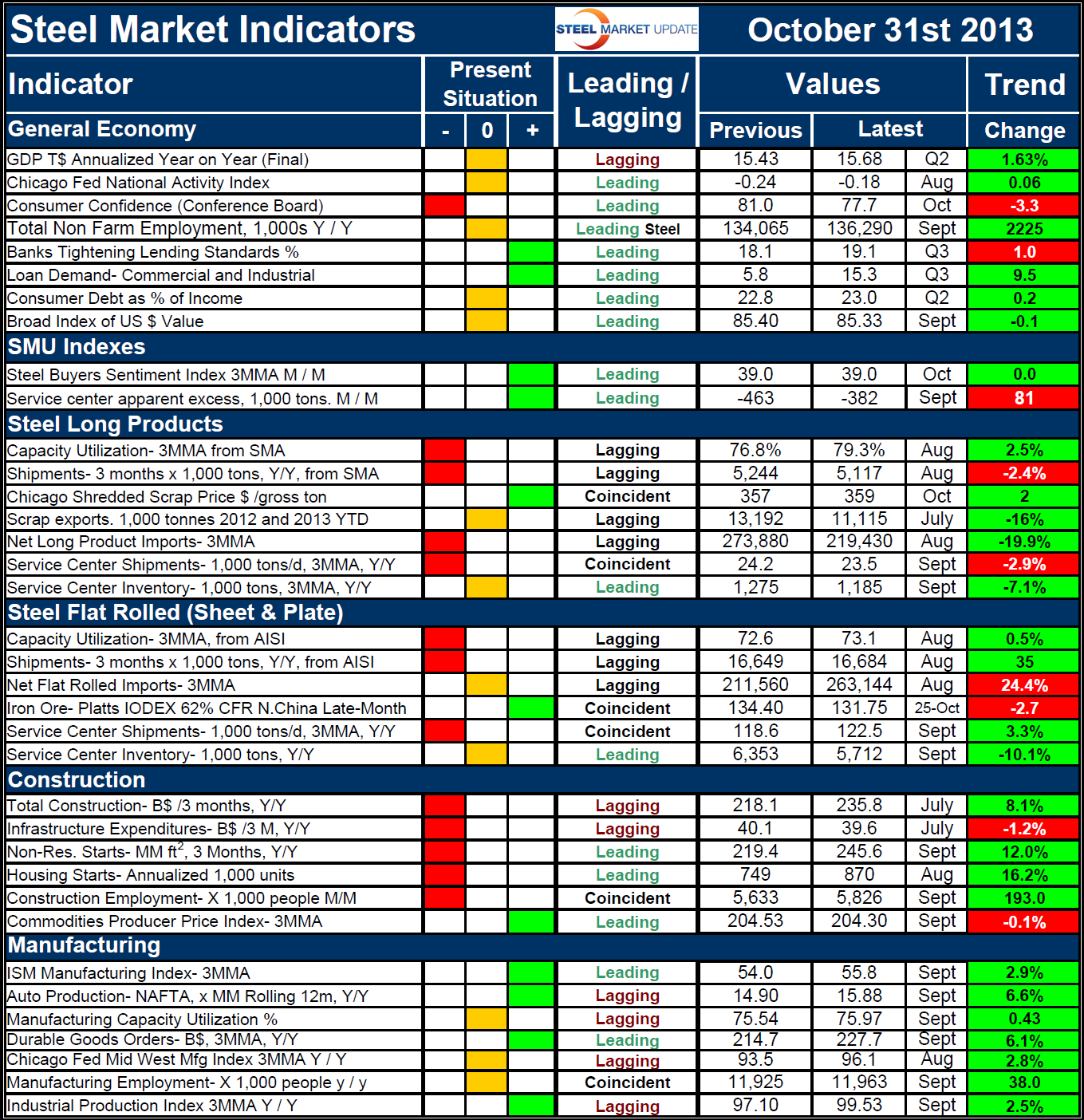SMU Data and Models

SMU Key Market Indicators: There is Positive Momentum
Written by Peter Wright
November 1, 2013
An explanation of the Key Indicators concept is given at the end of this piece for those readers who are unfamiliar with it.
The total number of indicators considered at present is thirty six. The present situation of eleven of the indicators based on historical standards was positive on October 31st and thirteen were negative; this was no change from last month’s report. This continues to be the best result since this analysis was first published in March when seven indicators were positive by historical standards and fourteen were negative.
The present situation of the general economy is pretty much in a holding pattern with five indicators in neutral, two positive and one negative. The SMU buyer’s index and the SMU service center excess statistics are both currently positive by historical standards. Present situation indicators for long and flat steel products are similar. Both raw materials indexes, scrap and iron ore are positive, Shipments and capacity utilization are negative by historical standards. Net imports are negative for long products and neutral for flat rolled. All the construction indicators except the producer price index of commodities are negative at present. All the manufacturing indicators are either positive or neutral.
The quantitative analysis of the value of each indicator over time is shown in the “Trend” column. At present trends are moving in the right direction. Twenty nine of thirty six indicators are improving; this is an increase of one on the positive side since last month and is also the best result since this analysis was initiated in March when seventeen trends were positive and eighteen negative.
Six of eight indicators of the general economy are headed in the right direction. Consumer confidence took a sizeable hit this month as a result of the government shutdown and bank lending standards have a negative trend though not by much.
The Steel Market Update Buyer’s Sentiment was unchanged from the last report and the Apparent Deficit declined from 463,000 tons to 382,000 tons still indicating pent up demand at service centers that will have to be released sooner or later.
The trends for long and flat products are currently almost opposites. Long product shipments at the mill and service center levels were down as flat rolled were both up. Net imports of long products declined 19.9 percent as flat rolled increased by 24.4 percent. The price of scrap rose as the price of iron ore declined. The only point of similarity was that inventories at service centers declined for both product groups. All the construction indicators except infrastructure expenditures and the producer price index of commodities are improving as are all of the manufacturing indicators.
The key indicators analysis confirms our experience that the current market is not great but tells us that most trends which are quantified are moving in the right direction and there is positive momentum. The trends specific to the steel market are believed to be negatively affected by political uncertainty and not to be representative of true demand at the end market level. We believe a continued examination of both the present situation and direction will be a valuable tool for corporate business planning.
Explanation: The key indicators chart is designed to give a snapshot of the steel market on a specific date. The chart is stacked vertically to separate the primary indicators of the general economy, of proprietary Steel Market Update indices, of both flat rolled and long product market indicators and finally of construction and manufacturing indicators. The indicators are classified as leading, coincident or lagging as indicated.
Columns in the chart are designed to differentiate between the current situation and the direction in which the market is headed. The present situation is sub-divided into, below the historical norm (-), (OK), and above the historical norm (+). The “Values” section of the chart is a quantitative definition of the market’s direction. In cases where seasonality is an issue, the evaluation of market direction is made on a three month moving average basis and compared year over year to eliminate this effect. Where seasonality is not an issue concurrent periods are compared. The date of the latest data is identified in the third values column. Values will always be current as of the date of publication. Finally, the far right column quantifies the trend as a percentage or numerical change with color code classification to indicate positive or negative direction.

Peter Wright
Read more from Peter WrightLatest in SMU Data and Models

SMU Scrap Survey: Sentiment Indices rise
Both current and future scrap sentiment jumped this month, though survey participants reported responses before key trade news was announced.

SMU Survey: Sentiment splits, buyers have better view of future than the present
SMU’s Steel Buyers’ Sentiment Indices moved in opposite directions this week. After rebounding from a near five-year low in late June, Current Sentiment slipped again. At the same time, Future Sentiment climbed to a four-month high. Both indices continue to show optimism among buyers about their company’s chances for success, but suggest there is less confidence in that optimism than earlier in the year.

SMU scrap market survey results now available
SMU’s ferrous scrap market survey results are now available on our website to all premium members. After logging in at steelmarketupdate.com, visit the pricing and analysis tab and look under the “survey results” section for “ferrous scrap survey” results. Past scrap survey results are also available under that selection. If you need help accessing the survey results […]

SMU flat-rolled market survey results now available
SMU’s latest steel buyers market survey results are now available on our website to all premium members. After logging in at steelmarketupdate.com, visit the pricing and analysis tab and look under the “survey results” section for “latest survey results.” Past survey results are also available under that selection. If you need help accessing the survey results, or if […]

SMU Survey: Sheet lead times stabilize, plate contracts
Mill lead times for sheet products were steady to slightly longer this week compared to our late June market check, while plate lead times contracted, according to steel buyers responding to this week’s market survey.

